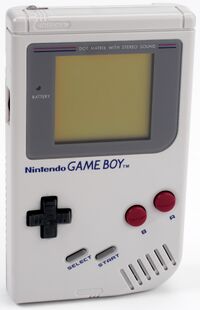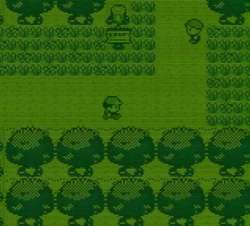
The Game Boy, sometimes shortened as GB, is an 8-bit cartridge-based handheld console produced by Nintendo and was originally released in 1989. Although often believed by fans to be the first handheld console ever made, it is not actually such, as unsuccessful products predates it as early as the late 1970s and Nintendo released the Game & Watch series in 1980 which lasted until 1991 (itself later inspired the Nintendo DS). However, the Game Boy is the first of its kind to be a portable console with interchangeable games like that of home consoles and can do multiplayer with a link cable, and therefore the first to be majorly successful. It is technically Nintendo's second handheld console, the first of the Game Boy line, and was intended to be a handheld version of the Nintendo Entertainment System. Despite the Game Boy being primitive by today's standards due to it having a crude, unlit dark green monochrome LCD screen with minimal contrast and requires 4 AA batteries to power it on, it was a revolutionary console of its age. The handheld itself is famously known for marking the debut of Tetris, Nintendo's Kirby series, and of course, Pokémon.
Part of the 16-bit era (Fourth generation) of gaming alongside the Super Nintendo Entertainment System, the original Game Boy competed with the Sega Game Gear, Lynx Atari Lynx, and NEC TurboExpress. Although the Game Boy is least technologically advanced of its market, as all its rivals had color screens with backlights while being the complete opposite, it had the advantage for its lower price, durability, less-power consuming hardware, being capable of lasting many hours longer - up to between 15 to 35 hours (the Game Gear in comparison can only last up to 5 hours with 6 AAs), as well as having a significantly larger library of games. It became by far the best-selling handheld console of its generation and eventually retired in 2003 - two years after the release of the Nintendo GameCube.
The Game Boy has the A, B, Start, and Select buttons as well as a D-Pad which makes the controls similar to that on the NES. In 1995, a new version of the Game Boy, as part of Nintendo's "Play It Loud!" campaign, was released. This version is exactly the same as the original; the only difference is that it was released in a wide variety of colors such as red, blue, green, and even clear. The Game Boy also received two other later variations in 1996 and 1998, respectively, the Game Boy Pocket and Game Boy Light, the latter of which remained exclusive to Japan.
In 1998, nearly a decade after its initial release, the Game Boy received a successor, the Game Boy Color. The two are often paired together, especially as some Game Boy games are backward-compatible with the Game Boy Color and sometimes vice versa, if the game allowed for it, as in the case of Pokémon Yellow Special Pikachu Edition (international version only) and Pokémon Gold Version and Pokémon Silver Version.
The Game Boy is the original system for which the long-running Pokémon games were released, something that occurred at the tailend of the console's lifespan. In spite of this, the Generation I games quickly became its best-selling titles.
Pokémon games
Game Boy games are generally released on a gray cartridge medium like other older Nintendo cartridge-based consoles, although the Pokémon core series games have a unique cartridge color often corresponding to the color within the game's title (except the Japanese versions). Only a few core series Pokémon games were released for the system:
- Pocket Monsters Red and Pocket Monsters Green (released February 27, 1996 in Japan)
- Pocket Monsters Blue (released late 1996 in Japan)
- Pokémon Yellow Special Pikachu Edition (first released September 12, 1998 in Japan)
- Pokémon Red Version and Pokémon Blue Version (first released September 28, 1998 in America)
Early Game Boy Color games were generally released on a black cartridge shaped like original Game Boy games with the header "Game Boy," allowing for backward compatibility on actual Game Boy units, whereas clear Game Boy Color cartridges have the header "Game Boy Color," indicating that they cannot be played on Game Boys, and if the user attempts to play it on an original Game Boy, an error message is shown. A relative Pokémon example is that Pokémon Trading Card Game was released on a black cartridge, so it can also be played on a Game Boy, whereas Pokémon Puzzle Challenge was released on a clear cartridge, so it cannot be played on a Game Boy. While Pokémon Gold Version and Pokémon Silver Version both have a uniquely colored cartridge, they have the shape of a black Game Boy Color cartridge, and they were designed for backward compatibility on original Game Boy units. Their follow-up special edition title, Pokémon Crystal Version, does not make use of this.
The Super NES has a peripheral named the Super Game Boy, for which both Game Boy and dual-compatible Game Boy Color games can be played on. Several Game Boy games, starting from around when the Super Game Boy was released in 1994, and dual-compatible Game Boy Color games have enhanced features if played on the Super Game Boy, most notably a border that surrounds the game screen and certain color palettes especially utilized during parts of the game. All Pokémon games for the Game Boy make use of these features, as well as dual-compatible Pokémon games for the Game Boy Color.
Sales
The Game Boy is one of the best-selling game systems of all time, having sold around 64,420,000 units worldwide (more than 118 million if counting the Game Boy Color). Despite only being released around the end of the console's lifespan, Pokémon Red and Blue (including their Japanese counterparts) as well as Pokémon Yellow managed to collectively become the highest-selling games for the system, with 46 million sold, surpassing even Super Mario Land from the Mario franchise and Tetris, both of which are the launch titles for the Game Boy.
Trivia

- The slogan of the Game Boy is "Now you're playing with power; PORTABLE POWER!", a modification of the NES'.
- The Game Boy's original retail price in 1989 was $89.99, which is equivalent to $228 as of 2024.
- Surprisingly, as found in recent years, in spite of its age, a Game Boy in good condition, with its 30 hours of battery life, surpasses all of Nintendo's future handhelds, including the Nintendo Switch hybrid console and its own later revisions.
- Some of the Game Boy's most popular games outside of Pokémon as well as its launch titles include Kirby's Dream Land, Dr. Mario, The Legend of Zelda: Link's Awakening, Donkey Kong Land, and more.
- Due to the handheld's remarkable durability, one particular Game Boy unit from an owner during the Gulf War in 1991 was known to have survived a bomb explosion and was still operational despite the damage of its front end being scorched black from the flames and only the screen needs replacement. It was on display in the Nintendo New York store for many years running a copy of Tetris until 2023 when it was sent back to Nintendo of America HQ, presumably to preserve it.
- The Game Boy's library consists of 1,043 games.
- As it is a late 1980s handheld console, the original "pea soup" LCD screen of the Game Boy, although its internal hardware was a huge leap forward to the earlier Game & Watch systems in comparison, due its rather outdated STN design, is infamously known to be hard to see, has major motion blur, and in some cases, can become defective prematurely, leading some fans claiming it do not age well today. For its Game Boy Pocket/Light and soon after Color revisions nearly a decade after its release, they use an updated FSTN screen to mostly eliminate the blurring effects and shows true black and white shading by removing the hue entirely. Despite this, however, all versions of the GB line until the Game Boy Advance SP, lack a backlight, requiring a third-party light adapter or through modifications to be able to play the consoles efficiently in low-light conditions.
- In fact when the Japanese Pocket Monsters Red and Green games were released, the public was initially uninterested, as they thought the Game Boy was obsolete.
- Despite its low-tech hardware, the Game Boy's 8-bit CPU, the Sharp SM83, interestingly, actually has a faster processing speed than the Super NES' Ricoh 5A22 CPU. The advanced 16-bit home console reads at 3.58MHz, while the handheld Game Boy is 4.19MHz.
- In terms of the Pokémon games, although the Game Boy is meant for Generation I, it is able to play Generation II games as well (except for Pokémon Crystal Version).









